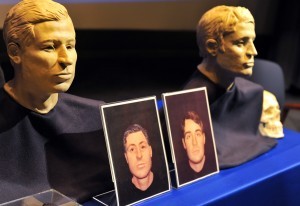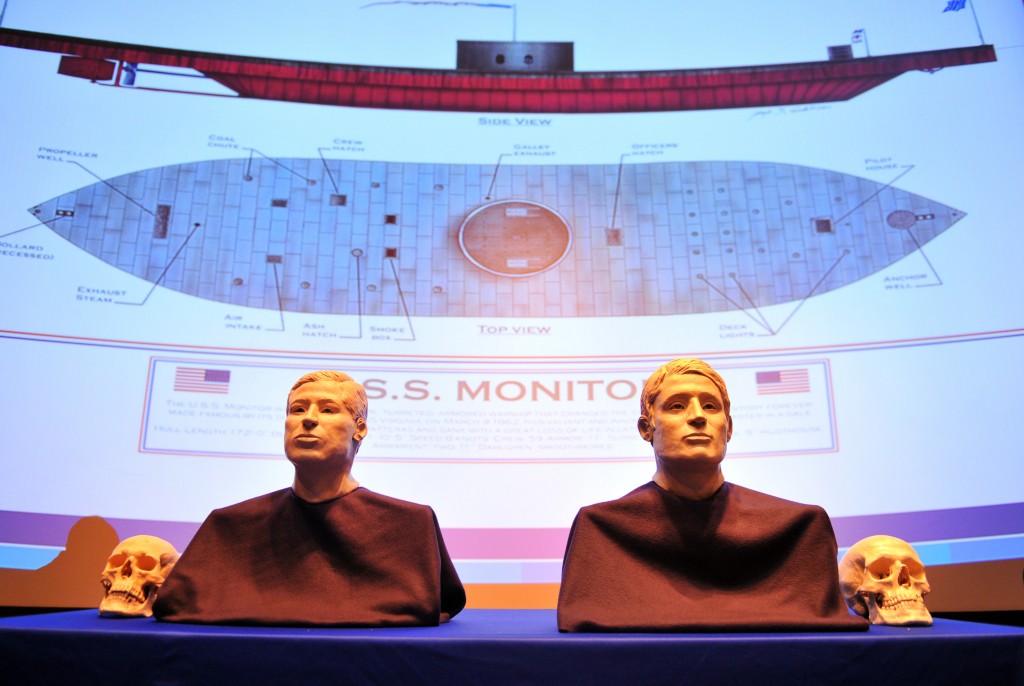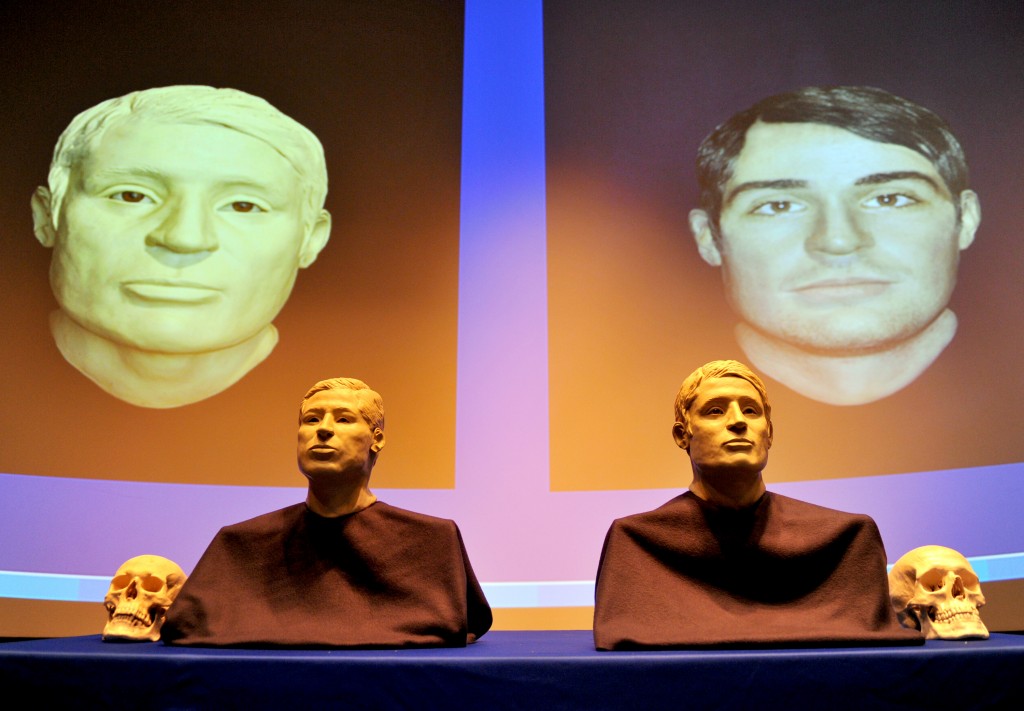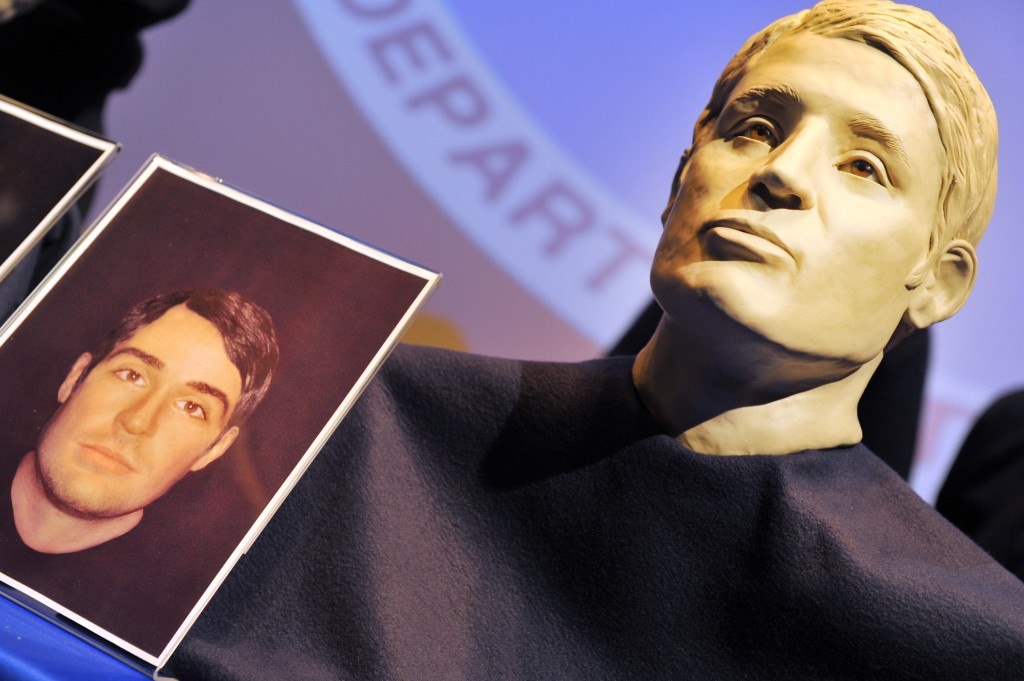By MC2 Gina Morrissette and MC1 Amy Kirk

120306-N-WE887-003 Washington, DC (March 6, 2012) The facial reconstruction of two sailors whose remains were discovered inside the the USS Monitor's gun turret after it was raised from the ocean floor in 2002, were revealed during a ceremony sponsored by the United States Navy Memorial Foundation and held in commemoration of the 150 anniversary of the USS Monitor an the battle of Hampton Roads. While much has been learned about the physical characteristics of the two sailors, their identities remain a mystery. USS Monitor sank off the shore of Cape Hatteras, NC in 1862, carrying 16 crew members to their death. (US Navy photo by MC2 Gina K. Morrissette/released)
As part of the 150th Anniversary of the USS Monitor and the legendary Battle of Hampton Roads, the U.S. Navy Memorial in Washington, D.C., hosted a commemorative program in collaboration with the National Oceanic and Atmospheric Administration’s Office (NOAA) of National Marine Sanctuaries, the Naval History and Heritage Command, and the Mariners’ Museum’s USS Monitor Center, March 6, 2012.
Honoring the memory of 16 Civil War Sailors who died aboard the ironclad vessel on Dec. 31, 1862, NOAA dedicated a memorial plaque and unveiled facial reconstruction sculptures of two sailors whose skeletal remains were discovered inside the ship’s gun turret after it was raised in 2002 off the shore of Cape Hatteras, N.C.
“It is fitting to have today’s event here at the Navy Memorial,” said Vice Adm. (ret) John Totushek, President and Chief Executive Officer, United States Navy Memorial Foundation, “It is here that we honor the sacrifices that so many Americans have made in duty to country while on the sea.”
Combining science and art, researchers hope the reconstructed faces will help someone identify the unknown men who went down with the Monitor.
“After 10 years, the faces are really the last opportunity we have, unless somebody pops up out of nowhere and says, ‘Hey, I am a descendant,’ ” said guest speaker James Delgado, director of the National Oceanic and Atmospheric Administration’s Maritime Heritage Program, in an earlier interview with The Associated Press.
During the ceremony, Delgado told the audience these two men stand as a reminder to the sacrifices service members make and the ultimate price they sometimes pay for the freedoms that we enjoy.
The facial reconstructions were done by experts at Louisiana State University, using the skulls of the two full skeletal remains found in the turret, after other scientific detective work failed to identify them. DNA testing, based on samples from their teeth and leg bones, did not find a match with any living descendants of the ship’s crew or their families.
While none of the clues found in the turret with their skeletal remains have been able to conclusively identify them, this much is known: one of them is around the ages of 30-32 and the other is probably in between the ages of 20-22, explained guest speaker Mary Manhein, director of LSU’s Forensic Anthropology and Computer Enhancement Services (FACES) Laboratory.
“Our greatest hope is that a descendent or two will come forward and maybe have some old family photographs and be able to help us identify these men and confirm it through DNA,” said Manhein. “This is a product of both art and science; we have had some very good success. Our success rate is really based upon publicity and getting these images out into the public eye. The publicity is what really brings these things to life.”
If no one steps forward following unveiling, Delgado said he hopes the remains can be buried at Arlington National Cemetery. “It’s time for these guys to get out of archival boxes and into a final resting place,” he said. “Like all who served and all who do pay the price, that, in and by itself, makes them important and worthy of remembrance and recognition.”
For the director of the Naval History and Heritage Command, Rear Adm. (ret) Jay A. DeLoach, the dedication ceremony held a personal connection.
“In 1960, I visited the Mariners’ Museum as a little kid, and later on, when the Monitor was first raised and put into the swimming pool, I was also there visiting,” said DeLoach. “This is definitely a personal connection for me as well as a personal connection for the Navy, because today we have brought to life two sailors from the past of the USS Monitor.”
Designed and built in 118 days, the Monitor made nautical history, fighting in the first battle between two ironclads in the Battle of Hampton Roads on March 9, 1862. The Monitor‘s confrontation with the CSS Virginia ended in a draw.
The Monitor sank about nine months later in rough seas southeast of Cape Hatteras, N.C., while it was under tow by the USS Rhode Island. Sixteen of the Monitor‘s 62 crew members died. The crew of the Rhode Island was able to rescue about 50 survivors.
The wreck was discovered in 1973 and designated the first national marine sanctuary in 1975. An expedition about a decade ago retrieved the revolving turret. It is now on display at the USS Monitor Center of the Mariners’ Museum in Newport News.

120306-N-WE887-001 Washington, DC (March 6, 2012) The facial reconstruction of two sailors whose remains were discovered inside the the USS Monitor's gun turret after it was raised from the ocean floor in 2002, were revealed during a ceremony sponsored by the United States Navy Memorial Foundation and held in commemoration of the 150 anniversary of the USS Monitor an the battle of Hampton Roads. While much has been learned about the physical characteristics of the two sailors, their identities remain a mystery. USS Monitor sank off the shore of Cape Hatteras, NC in 1862, carrying 16 crew members to their death. (US Navy photo by MC2 Gina K. Morrissette/released)

120306-N-WE887-002 Washington, DC (March 6, 2012) The facial reconstruction of two sailors whose remains were discovered inside the the USS Monitor's gun turret after it was raised from the ocean floor in 2002, were revealed during a ceremony sponsored by the United States Navy Memorial Foundation and held in commemoration of the 150 anniversary of the USS Monitor an the battle of Hampton Roads. While much has been learned about the physical characteristics of the two sailors, their identities remain a mystery. USS Monitor sank off the shore of Cape Hatteras, NC in 1862, carrying 16 crew members to their death. (US Navy photo by MC2 Gina K. Morrissette/released)

120306-N-WE887-004 Washington, DC (March 6, 2012) The facial reconstruction of two sailors whose remains were discovered inside the the USS Monitor's gun turret after it was raised from the ocean floor in 2002, were revealed during a ceremony sponsored by the United States Navy Memorial Foundation and held in commemoration of the 150 anniversary of the USS Monitor an the battle of Hampton Roads. While much has been learned about the physical characteristics of the two sailors, their identities remain a mystery. USS Monitor sank off the shore of Cape Hatteras, NC in 1862, carrying 16 crew members to their death. (US Navy photo by MC2 Gina K. Morrissette/released)


Pingback: USS Monitor sailors to buried at Arlington | historical tales
Ronald Foiles